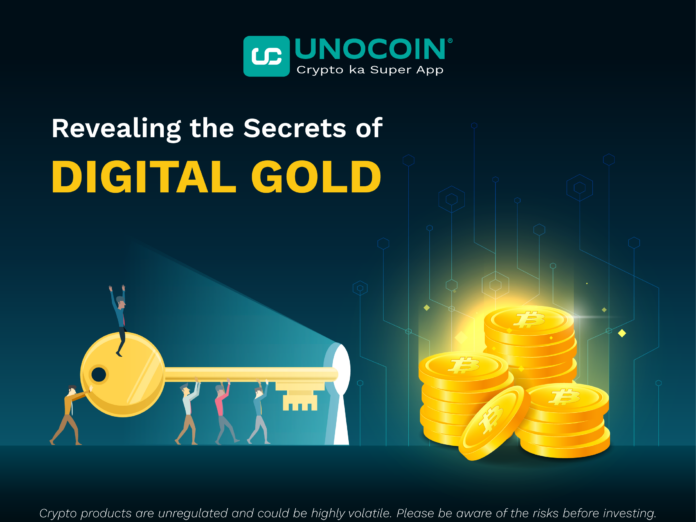Revealing the Secret of Digital Gold
Bitcoin, often referred to as “digital gold”, has become one of the most captivating and significant financial phenomena of our time. Its meteoric rise from obscurity to a market value exceeding a trillion dollars has left many wondering about the mystery of this digital currency. In this 1,500-word article, we’ll reveal the history, attributes, and unique characteristics that have earned Bitcoin the nickname “digital gold.”
The birth of bitcoin
To truly appreciate the essence of Bitcoin, we must begin at its birth. Satoshi Nakamoto, a pseudonymous entity or person, released a Bitcoin whitepaper in 2008 that outlined a peer-to-peer electronic cash system. The actual creation of Bitcoin took place in January 2009 with the mining of its genesis block. The goal was to create a decentralized digital currency that would operate independently of governments and financial institutions, a concept that remains central to cryptocurrency’s identity. You can buy sell and exchange bitcoin to other cryptocurrencies in India at Unocoin
Analogy of digital gold
The comparison between Bitcoin and gold is not arbitrary; it is rooted in specific attributes that both share:
Scarcity: Like gold, Bitcoin has a limited supply. There will only be 21 million Bitcoins in existence, making it a deflationary asset. This scarcity adds to its value.
Durability: As a digital asset, Bitcoin does not degrade or corrode. It exists on the blockchain indefinitely, making it as durable as physical gold.
Decentralization: Gold is not controlled by any single entity and the same is true for Bitcoin. It operates on a decentralized network of computers, making it resistant to censorship and control.
A keeper of value
One of the reasons Bitcoin is often referred to as “digital gold” is its role as a store of value. Traditionally, gold has been a hedge against inflation and economic uncertainty. Similarly, Bitcoin is increasingly seen as a means of preserving wealth over time. Its limited supply and growing adoption have made it an attractive option for investors looking to protect their assets from the devaluation of fiat currencies.
Historical Bitcoin Performance
A critical factor in the “digital gold” narrative is Bitcoin’s price history. From its humble beginnings when it was virtually worthless to its current status as a major asset, Bitcoin has seen significant price swings. These price movements have been driven by a number of factors, including market speculation, acceptance by institutional investors and global events such as economic crises.
Understanding Bitcoin’s historical performance is key to understanding the trust and belief many investors place in it. It has demonstrated resilience and the potential for substantial long-term growth, albeit with considerable volatility.
Cryptocurrency Investing Strategy
Now that we’ve uncovered the secret behind Bitcoin’s “digital gold” status, let’s think about practical strategies for investing in the cryptocurrency. Whether you’re a novice or a seasoned investor, these insights can guide your approach.
HODLing vs. trading
The first decision you will face is whether to HODL (hold your assets for the long term) or engage in active trading. HODLing is a strategy where you buy a cryptocurrency and hold it regardless of short-term price fluctuations. Trading, on the other hand, involves actively buying and selling assets in an attempt to profit from price movements.
Each approach has its advantages and disadvantages. HODLing requires patience and faith in the long-term potential of the assets you hold. Trading requires more active involvement and a deep understanding of market dynamics. Both strategies can be profitable depending on your goals and risk tolerance.
Diversification
Diversifying your cryptocurrency portfolio is a key risk management strategy. Spreading your investments across different assets can help mitigate the impact of price fluctuations. While Bitcoin may be your main holding, consider adding other cryptocurrencies to your portfolio to enhance your overall strategy.
Diversification can extend to other types of investments, such as stocks, bonds or real estate, depending on your risk tolerance and investment horizon.
Risk management
The cryptocurrency market is notorious for its price volatility, and risk management is critical to protecting your investments. Some basic risk management techniques include:
Setting Stop Loss Orders: These orders will automatically sell your assets if their price falls to a certain level, limiting potential losses.
Determining the right allocation: Decide how much of your portfolio you want to allocate to cryptocurrency. It should align with your risk tolerance and investment goals.
Stay informed: Stay informed about market news, technological developments and regulatory changes that could affect your investments.
Security precautions
Securing your cryptocurrency holdings is of the utmost importance. Unlike traditional assets, cryptocurrencies are digital and are vulnerable to theft if not adequately protected. Here are some basic safety precautions:
Hardware Wallets: Consider using hardware wallets to store your cryptocurrency offline, making them resistant to online hacking attempts. To know more about hardware wallets here
Two-Factor Authentication (2FA): Enable 2FA on your exchange accounts and wallets to add another layer of security. To know more about Crypto usage safety measures kindly refer here
Best practices: Follow security best practices, such as regularly updating your software, using strong, unique passwords, and being wary of phishing attempts.
Regulatory aspects
The cryptocurrency landscape is constantly evolving and regulatory aspects can have a material impact on your investments. Regulations can vary significantly from country to country and it is essential that you stay informed of the legal environment in your jurisdiction.
Regulatory changes may affect how you buy, sell and report your cryptocurrency holdings. Make sure you follow tax laws and financial regulations to avoid legal problems.
Conclusion:
In conclusion, Bitcoin’s “digital gold” status is well-deserved due to its scarcity, durability, and decentralization. Understanding its history and the factors that contributed to its rise is essential for any investor looking to enter the cryptocurrency space. When investing in cryptocurrency, consider your risk tolerance, diversification, risk management, security and regulatory factors to make informed decisions. Whether you’re an experienced investor or just starting your journey, these strategies will help you navigate the exciting world of digital gold.
Please find the list of authentic Unocoin accounts for all your queries below:
- YouTube Channel: https://www.youtube.com/c/Unocoin/videos
- Newsletter: https://medium.com/subscribe/@Unocoin_growth
- Blogs: https://blog.unocoin.com
- Instagram: https://www.instagram.com/unocoin/
- Twitter: https://twitter.com/Unocoin
- Facebook: https://www.facebook.com/unocoin/
- LinkedIn: https://in.linkedin.com/company/unocoin
- Telegram Group: https://t.me/Unocoin_Group
- Telegram Channel: https://t.me/+fasQhTKBsfA5N2Zl
- Telegram: https://t.me/UnocoinSupport_Bot
- E-mail id: [email protected]
- Contact details: 7788978910 (09:30 AM IST – 06:30 PM, Mon – Sat)
- App store link: https://apps.apple.com/us/app/unocoin/id1030422972?ls=1
- Playstore link: https://play.google.com/store/apps/details?id=com.unocoin.unocoinwallet
Disclaimer: Crypto products are unregulated as of this date in India. They could be highly volatile. At Unocoin, we understand that there is a need to protect consumer interests as this form of trading and investment has risks that consumers may not be aware of. To ensure that consumers who deal in crypto products are not misled, they are advised to DYOR (Do Your Own Research).




![Fundamental Analysis in Crypto [Updated Guide] A Comprehensive Guide to Asset Valuation.png](https://blog.unocoin.com/wp-content/uploads/2024/11/A-Comprehensive-Guide-to-Asset-Valuation-218x150.png)